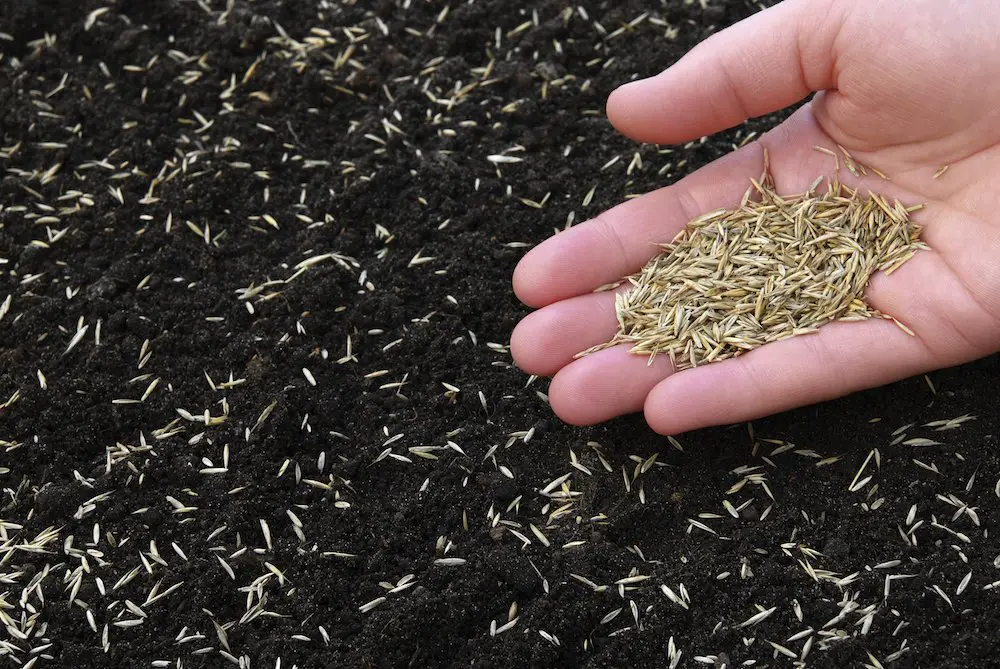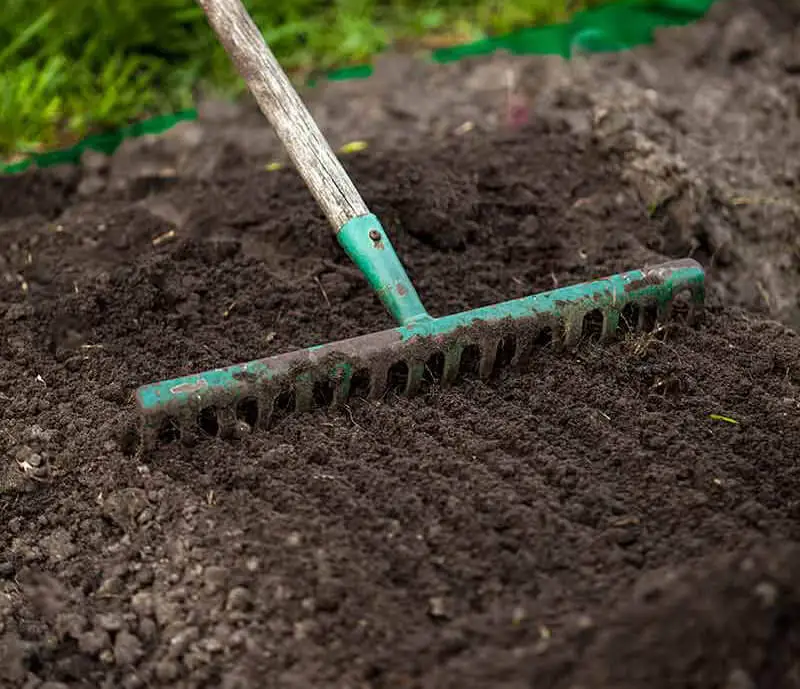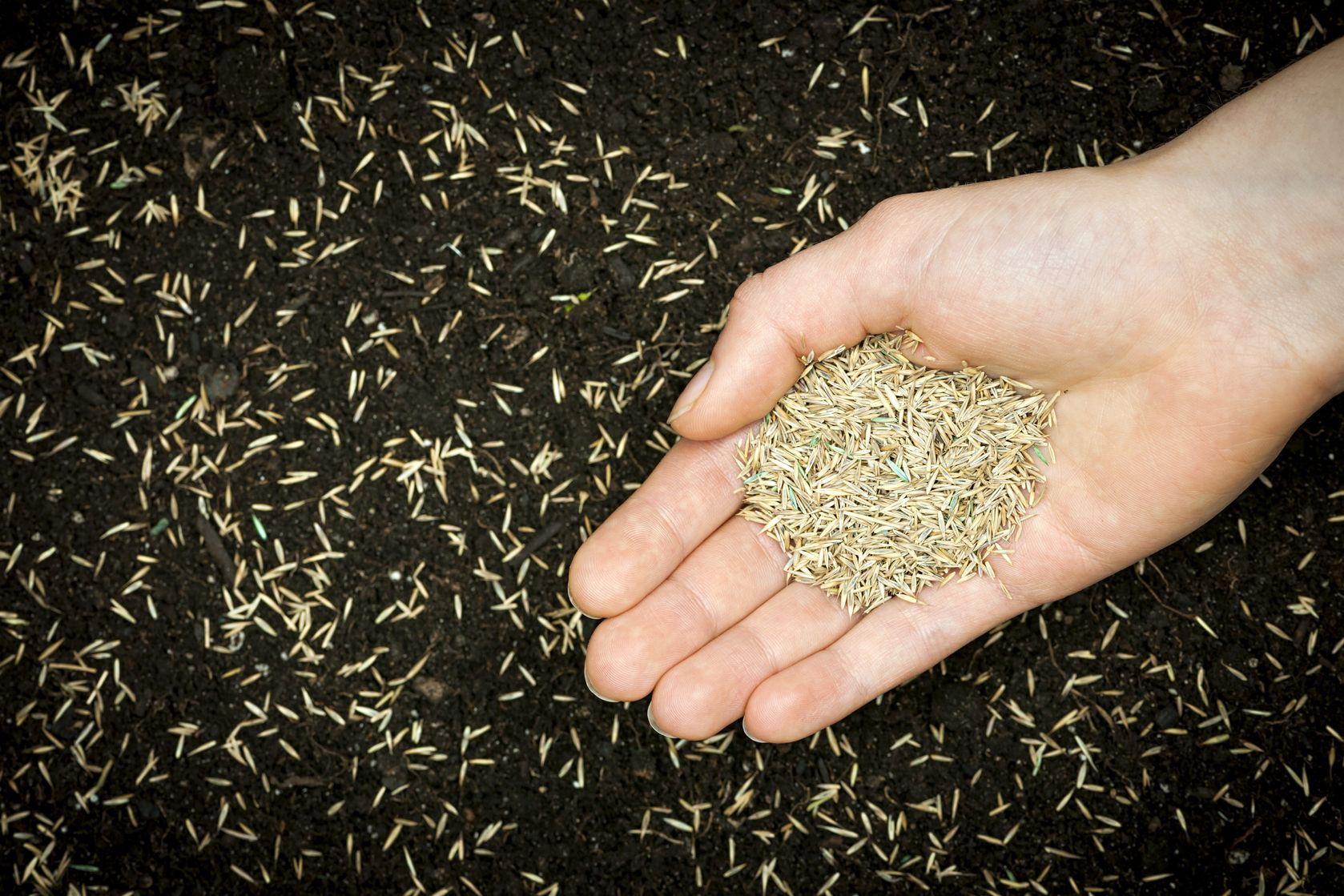Mowing A New Lawn: Be Gentle
Be careful with the lawnmower the first few times your new turfgrass is mowed. The roots will not be long or well-established, so it will be easy to accidentally rip up the young plants. Sharpen the mowers blade, so you cut, not tear the tender plants. Try to start the mower on a flat surface away from the lawn, and minimize the number of turns you make with the mower. Abide by the rule of , which is to never remove more than a third of a grass plant in one mow.
Once you have mowed at least once, cut back on your frequent shallow watering, and switch to watering a couple of times a week, deeply. Get water down to six or eight inches deep to encourage your new lawn to root deeply. Once established the lawn will start spreading to cover any gaps.
After about six to eight weeks, your lawn should be well-established. Hit it with a little more fertilizer to encourage deep roots, and take down your keep off the new lawn signs. Your new lawn is ready for you.
Test And Amend Your Soil
You have exposed and evened out the planting surface, but its not yet time to lay down the seed. For the seeding project to have the best chance of success, you need to know what kind of soil you have. So test.
Good: At a minimum, test for pH. Thats a measure of the acidity or alkalinity of your soil. Most grasses like slightly acidic soil, with a pH of 6.2 to 7.
A simple moisture and pH tester can be found for $10.
Better: Also test for the major nutrients in your soil. For around $20, you can get a kit that in addition to testing for pH, will test for the major plant-building nutrients, nitrogen, phosphorus and potash the N, P, and K numbers you see on all bags of fertilizers.
Best: Test for both major and minor nutrients. There can be more than a dozen you can test for, and which ones you test for will vary depending on the testing facility and on which micronutrients tend to be lacking in your area. For that, youll need either a fancier kit or take your soil samples to a testing lab.
There are private laboratories, and also many state extension service offices. The latter often offer low-cost or even free soil testing. Here are four very good soil tests you can buy on Amazon.
Test the soil as soon as you can. There can be a wait of up to two weeks to get test results back. If you dawdle, you could miss your ideal planting window.
Grass Seed Alone Or A Fertilizer And Mulch Mix
You have one final decision to make whether to buy a seed product that incorporates fertilizer and mulch, or whether you will purchase fertilizer and mulch separately.
The all-in-one products tend to be more expensive, but are more convenient.
Measure your lawn area in square feet, and purchase enough seed to cover that area. Generally, the bags are marked as the number of pounds needed per 1,000 square feet. Fudge your purchase on the high side so youll buy a little more than needed. That way you should have some left over in case you need to come back and reseed some bare spots.
If you are fertilizing separately, broadcast the fertilizer per the manufacturers instructions, but do not till it in.
Don’t Miss: Who Sells Ariens Lawn Mowers
How To Grow Monkey Grass From Seed
The Liriope muscari is a type of evergreen plant native to East Asia.While most people grow monkey grass by moving an existing plant to a new spot, you can also grow liriope from a seed.It is easy to cultivate lilyturf once you know all the steps involved with germinating the seeds and moving them to your yard or garden.
You Can Plant Grass Seed Anytime During The Growing Season But Doing So In Fall Takes Advantage Of Cooler Temperatures And Milder Sun

How many plants are in your yard? If you have a lawn, the answer is: Too many to count. The average quarter-acre lawn contains millions of grass plants.
Fortunately, these plants start easily from seed. Grass is one of the most common plants on the planet, and one of the easiest to germinate. Still, timing and technique are important. Read on to learn more about sowing grass seed in the fall.
On This Page
Recommended Reading: How Much To Pay Teenager To Mow Lawn
Get The Timing Right: When To Seed
For cool-season grass seeds, either spring or fall are the preferred times, since these northern varieties of grass prefer warm soil and cool air.
In the South, warm-season grasses can be planted from late spring to mid-summer. Wait until the last chance of a late frost has passed, and the daytime temperature is in the 80s.
Watering New Grass Seeds
The best advice for watering new grass seed is simple. Since you only get one chance to germinate seeds correctly. The right amount is very important. Not enough water will kill the sprout and too much water can leave less than ideal results.
The right amount of watering is very important. Not enough water will kill the sprout and too much water can leave less than ideal results.
All grass types need to be kept moist at all times during their establishment phase, this is to ensure there is always an ample amount of moisture in the soil. This ensures the greatest, and only chance of survival and establishment of the new grass seedlings.
Read Also: How To Change Oil In Toro Lawn Mower
How To Prepare The Ground For Turf Or Grass Seed Step
The video below from Rolawn shows how to prepare the ground, step-by-step.
Preparing the ground for grass seed or turf is fairly straight forward although it can be hard work. You should take your time and be as thorough as possible.
For best results, give yourself a couple of months to do it. You can do it quicker but the results wont be nearly as good.
You Can Find A Shady Spot To Plant Your Seeds
Monkey grass plants can be damaged by too much sun exposure.They do best in shady areas with a small amount of sunlight.Below large trees and fabric canopies are some good planting spots.If you want, you can plant your monkey grass seeds in gardening pots, keep them inside, and then transplant them down the road.
Don’t Miss: Lawn Gnats In Grass
How To Germinate Grass Seed Complete Guide
In the ground, grass seeds can seem like watched pots for a long time as they meld together and sprout. You are left in suspense for weeks when it boils, and seeds never boil. Waiting weeks to find out if you planted them correctly or germinated successfully requires patience and planning. Lets explore How To Germinate Grass Seed?
Most people ask how long for grass seed to germinate? To strongly grow grass seeds, many factors need to be in place. The key ones are moisture, soil temperature, and light.
In some grass seeds, germination can take as long as 30 days. Pre-germination techniques can be used at this stage to speed up the germination process. Specific changes can be made to these growth factors at this stage.
Establish A Watering Schedule To Keep Seed Moist
Your new seedlings will need to be kept moist to ensure they germinate. For the first few weeks after planting, give your seedbed light, frequent waterings two to three times per day, in the early morning, late morning, and early afternoon.
The germination period, or the time it takes for your seed to start growing, can vary depending on what type of grass seed variety youve planted. Perennial ryegrass, for example, only takes about 7 14 days to germinate. Kentucky bluegrass, on the other hand, takes longer to germinate in approximately 21 28 days.
Once your grass has reached a height of four inches, you can begin to decrease your waterings to two to three times per week. Water for longer periods during this time for approximately 30 minutes per zone. On average, established lawns need about 1 1.5 inches of water per week, including rainfall.
Recommended Reading: How To Advertise My Lawn Mowing Business
Covering Grass Seed When Overseeding
Overseeding an existing lawn with new grass seed is a tough job. The grass that is already present can shade out new seedlings if the proper steps arent taken. For the best results, dethatch your lawn first. Then, use a core aerator to loosen the soil. Spread lawn starter fertilizer, followed by a 1/4 inch layer of compost. Then, spread the grass seeds, cover your seeds by raking the compost over them, and water your lawn.
- Dethatch your lawn if the thatch layer is more than 1/2 inch thick.
- Aerate your lawn using a core aerator.
- Apply lawn starter fertilizer in the area that will be overseeded.
- Spread 1/4 inch of compost over the lawn. Rake it to fill aeration holes and ensure it does not smother existing grass.
- Spread grass seed. Use additional seed if desired, since it is more difficult for seeds to sprout in an established lawn.
- Use a rake to cover the grass seed with 1/81/4 inch of compost.
- Water for 1015 minutes immediately after the seed is covered.
Some types of grass respond better to overseeding than others. Cool-season grasses are good candidates for overseeding because most varieties do well growing in established lawns. Warm-season grasses may struggle when overseeding. By preparing your soil properly, you get the best results from overseeding with all grass types.
S To Plant A New Lawn Successfully

Planting a new lawn is a big job it may be best to tackle the project in sections. You can begin this process by redoing the worst or most visible lawn areas, and then make plans to tackle the remaining areas the following year.
Starting with smaller sections instead of the entire lawn keeps the job manageable and makes the critical step of watering feasible for homeowners who do not have in-ground sprinkler systems. However, whether you plant a new lawn in stages or all at once, you will need to take the following steps:
Recommended Reading: How To Get Rid Of Wild Violets In Your Lawn
Plant Grass Seed And Enjoy A New Lawn
In many gardens, the lawn is a vital balancing element, the perfect backdrop to the more colourful flowering parts of the garden. Without it, mixed borders can seem messy and overwhelming, and subtle planting combinations just get lost in the crowd. Big or small, an expanse of green has a unifying effect, providing a visual link between the different elements of a garden.
If you’re looking to create a new lawn area, grass seed is a low-cost way to get some greenery into your garden. There are a range of grass types available.
Read on for step-by-step help on laying a new lawn from grass seed. Alternatively, if you’re looking for speedy results, head over to our helpful guide on laying turf.
How Long Does Grass Seed Take To Grow
How long it will take for your new grass seed to begin to grow really depends on where you live, your climate and what type of grass you plant. It can take anywhere between 3 and 28 days for new grass seed to begin to grow.
A beautiful, vibrant lawn not only looks great, but it also provides a place for you and your family to play, relax and enjoy. A consistent water schedule for watering new grass seed is key to making sure youre growing a healthy, lush green lawn that will give you years of enjoyment and beauty.
| Previous Article |
Don’t Miss: Riding Mower Sale Lowes
How To Sow Grass Seeds
Once your soil is ready, rake it in straight lines, creating shallow furrows. To encourage germination, spread a lawn-starter fertiliser at the prescribed rate. Then, separate your grass seed into two equal amounts. Spread the first batch in one direction and the second at right angles to the first. This gives you a more even distribution.
If both your soil and your seeds are dark in colour and its hard to tell where youve left seed and where you havent, you can use the old trick of mixing some fine white sand with your seed to make it more visible on the ground.
If both your soil and your seeds are dark in colour and its hard to tell where youve left seed and where you havent, you can use the old trick of mixing some fine white sand with your seed to make it more visible on the ground.
Once the seeds are down, cover them by lightly raking the surface of the soil. Water the area twice a day with fine mist spray until the seedlings have taken hold. Keep all foot traffic away from the area until full germination. Your seeded lawn should take about eight weeks to establish.
How To Plant Grass Seed: A Simple Guide To Success
This post may contain affiliate links. If you click on an affiliate link and make a purchase, we receive a small commission at no extra cost to you. Find our full disclosure here.
Lawns are everywhere. Some are highly tended others, not so much. My own lawn is a mixed planting of three types of turf grass , clover, violets, ground ivy, and various other weeds, which is exactly how I like it . Regardless of how perfectionistic you are about your lawn, at one point or another, youll find yourself needing to plant grass seed. Whether its to fill in a bare spot left behind by Fido or a wayward snowplow, or to install a brand-new lawn after a construction project, learning how to plant grass seed is a necessity for most homeowners. This article offers a simple guide to success, no matter the reason for your reseeding efforts.
You May Like: Can You Hydroseed Over An Existing Lawn
How Long To Water New Grass Seed
How long to water new grass seed depends on your soil conditions and your sprinkler setup. In general, ten minutes of watering per session will provide enough water to keep the top couple inches of soil moist.
As your new grass seed grows and flourishes, you can water deeper and less frequently this will encourage established grass roots to extend deeply into the soil. When watering grass seedlings, gradually increase your morning watering sessions over time, while decreasing your evening watering. Eventually, youll want to water between 6 and 10 am, while the weather is still cool. An established lawn typically requires about 1 inch of water per week, including rainfall.
Use the chart below to help you plan out your ideal watering schedule:
Choose The Right Type Of Grass
Not all grass types are suited to all environments, and quality grass seed is expensive. Before you buy, spend a week and be observant about the space you are planning to establish a lawn.
Its important things to consider these factors when selecting what grass seed to plant.
- Is your lawn exposed to a lot of sun?
- Do parts of your lawn get light or heavy shade?
- Do you live in a spot where you get rain or is it very dry?
Its also important to consider your soil type is it sandy or heavy clay?
Also Check: Wild Violet Herbicide
The Best Time Of Year For Preparing Ground For Turf Or Grass Seed
In order to create the best looking lawn you can, you should allow yourself plenty of time to prepare the ground.
Generally, Autumn is the best time for laying turf or sowing grass seed.
The soil is warm from the Summers sun, there are very few weed seeds in the air and the rain comes to help water the area and encourage quick establishment and growth.
So, September and October are always good months.
I like to give myself a good 8 weeks to prepare the ground so if you plan on creating your new lawn in September, start preparing the ground in July.
Even if you dont create your new lawn until October, the hard work will have already been done.
How To Cover Your Grass Seed

The best way to complete a lawn seeding project is by spreading topsoil or compost on your lawn, spreading seed, and then raking the soil over the seeds to cover them. To accomplish this, you can add additional soil as necessary, until grass seed is covered to a depth of 1/81/4 inch. Special care should be taken depending on whether you are seeding bare soil or overseeding a lawn where grass is already growing.
Recommended Reading: Who Makes Cub Cadet Mowers
Spread The Grass Seed
Buy grass seed that’s recommended for your region. If youre not sure what type of grass seed to use, visit a local nursery or check with a university extension office. Next, use a handheld broadcast spreaderthe kind with a hand crankto disperse the seed over the planting area.
Broadcast spreaders are suitable for small- to medium-size yards, but if you’re planting a very large lawn, save time by dispersing the seed with a walk-behind drop spreader, which you can buy or rentor perhaps borrow from a neighbor.
After applying the grass seed, gently work the seed into the soil using a large plastic leaf rake. However, to avoid redistributing the evenly broadcasted seeds, which can result in uneven, clumpy grass growth, turn the rake upside down and use the back of the rake with very short, light strokes to work in the seeds.
